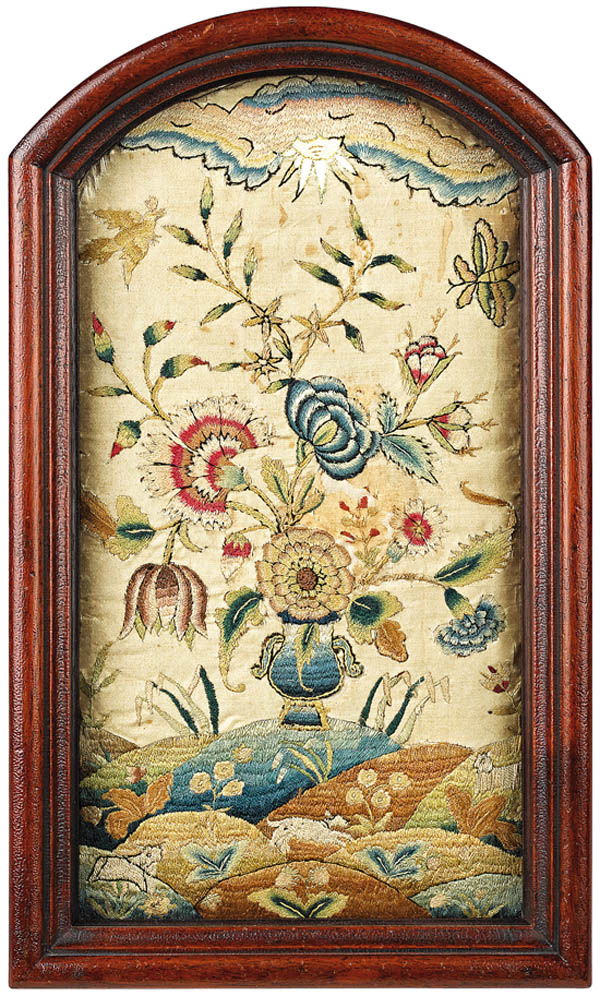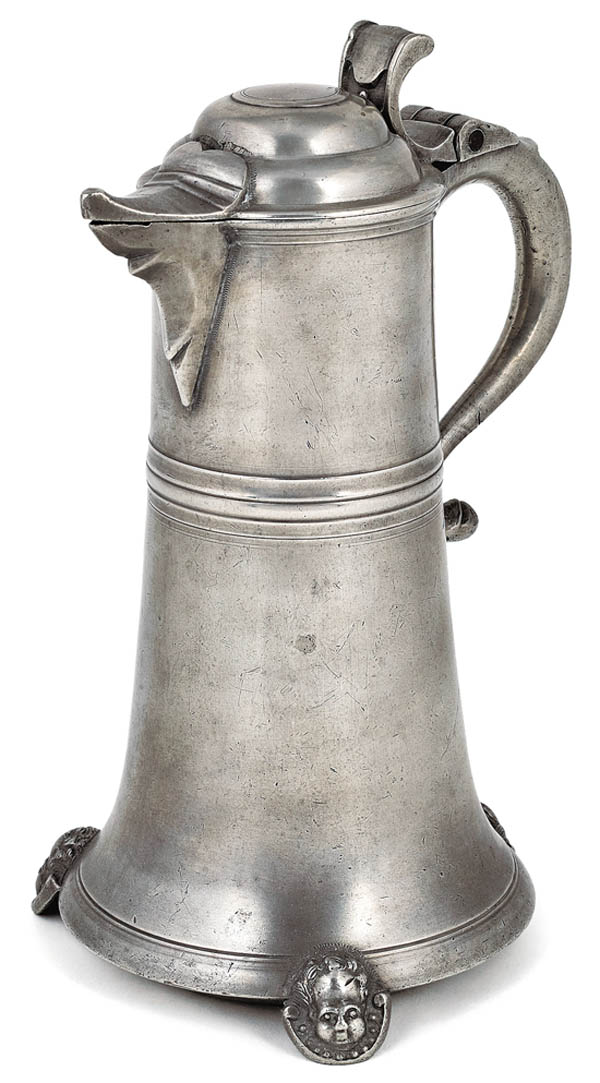The Collection Of Drs. Donald And Patricia Herr
Monumental Sale At Pook & Pook Slated For June 9 And 10
By Cynthia Beech Lawrence - June 03, 2022
Collectors of Pennsylvania German folk art for six decades, Donald and Patricia Herr became true connoisseurs, retaining only the best examples of an artists work, the best of a form, and the rarest and most highly sought-after examples. Researching and documenting their collection, Drs. Donald and Patricia Herr may have applied scientific method to antiques. They published studies and research papers on a wide range of Pennsylvania German subjects. They recorded their observations, made comparative studies, and researched provenance and the progress of objects, artisans, and families through time. The Herrs uncovered relationships and made connections, adding greatly to the study of Pennsylvania German artists and craftspeople. Throughout the collection, common family names crop up on diverse items. Alongside the colorful painted wooden creations of Joseph Lehn, one finds his copybook, dated 1843, and a fraktur by his son, Henrich Lehn, for his grandson, Joseph, born 1829. The Herr name is found on diverse objects, with a Herr family coverlet, a Grandmother Herr quilt, an 1828 David Herr watercolor fraktur of birds, and Herr family birth and baptismal frakturs. The Herrs research led to new discoveries, such as when Dr. Herr and Dr. Don Yoder collaborated to uncover the identity of the Sussel Unicorn Artist. Schoolmaster Christian Beschler (Northumberland County, ca. 1800) created fraktur, only 10 known works survive today, eight of which are taufscheine. Two of these rarities are a birth and baptismal certificate for Jacob Jaekle, dated 1796; and one for Magdalena Fuchs b. 1801. Both are profusely decorated with compass stars, hearts, unicorns, and parrots amid tulips, flowers, and vines. Other works in this stellar group include a Johann Heinrich Otto (Southeastern Pennsylvania active 1762-97) watercolor fraktur of a parrot and bird perched on stylized flowers, and works by Georg Frederich Speyer, Henrich Dulheuer, Samuel Bentz, John Zinck, Jacob Andreas, and Christian Strenge. Pook & Pook of Downingtown, Pa., will handle this important sale on Thursday and Friday, June 9 and 10. Patricia Herrs collection documents early schools of needlework. Three works from the Marsh School (Philadelphia 1723-95) include one by Ann Marsh herself, ca. 1730, a vibrant work with an urn of flowers with insect and bird, resting on a rolling lawn with sheep and a running dog, retaining the original tombstone arched walnut frame. Ann, alongside her mother, Elizabeth, taught the daughters of elite Philadelphia Quaker families the art of ornamental embroidery. Marsh works are rare, and according to Betty Ring, are the earliest identifiable group of Philadelphia needleworks. Seven works from the Lititz Moravian School include a silk on silk memorial embroidered sampler, attributed to Mary Ann or Rebecca Catherine Peterson, ca. 1833, in memory of their father. Another highlight is the earliest known Lititz silk mourning embroidery, ca. 1805, attributed to Sara Pim, Columbia Mourns for Washington. From the school of Mrs. Catharine Welshans Buchanan, a scarce Marietta, Lancaster County, silk-on-linen memorial needlework dated 1827 is inscribed, Eliz Groshs work made in Marietta in Mrs. Buchnans School in the year of our Lord 1811. A very rare Lampeter School silk-on-linen sampler, dated 1799, wrought by Phebe Harvey of Pennsbury Township, Chester County, is possibly the only known sampler naming the school. One more category highlight is an important Chester County needlework grouping of sewing articles. Made by Hannah Darlington, ca. 1785, each piece bears the makers name or initials. The most coveted makers of wooden boxes hold a special place in the collection. An important John Palm Boyer (1833-1901), Brickerville, Lancaster County, painted pine seed chest, ca. 1860, retaining its original faux grain decoration, the case with a fall front lid over 15 drawers, with a lower row of seven small drawers resting on bootjack feet. This cabinet remains in a remarkable state of preservation and is among the finest known examples of Boyers work. Of 23 Joseph Lehn-related pieces featured, one is a painted poplar seed chest with decoupage decorated crest and sides and a brick red ground. There are two 19th-cenury Lancaster Weber dresser boxes, one red ground and one blue, each with vibrant floral decoration, houses and trees. Two early 19th-century Lancaster County Compass Artist works are featured. One of very few known examples is a painted poplar slide lid box decorated with red and white pinwheel flowers on a dark blue ground. Another, of more traditional form, is a painted poplar dome lid box intricately and profusely decorated with compass and freehand flowers. An important John Drissel (Lower Milford Township, Bucks County, late 18th/early 19th century) painted pine slide lid box, the lid inscribed, Johannes Stauffer Anno 1797 John Drissel his hand, is decorated with tulips and white wavy lines on a brick red ground. Highly desirable Pennsylvania German carvings include a Wilhelm Schimmel spread-winged eagle, with original polychrome surface and unusual gilt body, which sits alongside two spirited Peter Brubaker (Lancaster County, 1816-98) carved and painted horses, one chestnut and one dapple grey. Engaging carved figural groups by George G. Wolfskill (Fivepointville, Lancaster County, 1872-1940) include an entire foxhunt. Works by John Reber (Lehigh County, 1857-1938) rarely come on the market, yet here are five of them, including his most ambitious work, an important carved and painted figure of the celebrated Standard bred pacer Dan Patch. Reber captured the majesty of Dan Patch, undefeated holder of the world record for the mile, with a mien of justifiable arrogance. His competition was so hopelessly outclassed that it stopped racing against him altogether. Metal works by artisans John Long (Sporting Hill, Rapho Township, Lancaster, 1787-1856) and Peter Derr (Tulpenhocken Township, Berks County, 1793-1868) exhibit the best qualities of their type. A rare John Long wrought-iron and brass fat lamp is inscribed, Fanny M. Erisman Manufactured By John Long. John Longs Betty lamps are considered by many to be among the finest examples of Pennsylvania German smithwork.... They exemplify the creativity and the love of form, function and design by the Pennsylvania Germans (Donald Herr, AAW, 2006). A Peter Derr iron, brass, and copper fat lamp is impressed, P.D 1860, and is one of three Peter Derr works to be offered. A Willoughby Shade (Montgomery County, Pennsylvania, mid-19th century) punched tin coffee pot is profusely decorated, not only with birds and flowers, but a parade of elephants march around its flared base. An exceedingly rare item, a York, Pa., copper saucepan and lid marked by John Lay is possibly the only example known. Pewter is the crown jewel in the Herr collection, abounding in rare and important items. A highly important Lancaster, Pa., pewter flagon, ca. 1770, bears the touch of Johann Christoph Heyne (Germany, Lancaster 1715-81). One of only two examples in private hands, it is remarkable for its cultural assimilation of styles (Herr, Pewter in Pennsylvania German Churches). Heyne came to America in 1742 as a member of the Moravians First Sea Congregation. Another work by Heyne, a ca. 1770 canteen, was a memorable find at a Carlisle flea market. The best American pewter exhibits simplicity, beauty, and innovation in the ways makers used their limited molds to create finely proportioned objects. One gifted pewterer stands above the rest. William Will (Germany, Philadelphia 1742-1798), patriot, statesman, and pewterer, was the son of John Will, who arrived in America in 1752. The Herrs collected the works of both father and son. Nine objects by William Will include sugar bowls, mugs, a tulip tankard, a drum teapot, and the jewel of the collection, an important coffee pot, ca. 1780. While few examples of this form exist, it has remained one of the most iconic pieces of American pewter. Standing sixteen inches in height, its clean, neoclassical lines and symmetry lend it visual impact. Of the works attributed to and bearing the touch of John Will (Germany, New York 1696-ca.1774), an important flagon and chalice, ca. 1760, has been traced to the Round Top Lutheran Church, Bethel, Duchess County, N.Y. Other highlights include a New York oval teapot, ca. 1745, bearing the touch Francs Bassett I, one of the rarest forms of American 18th century design. Of the seven Philadelphia items in the collection bearing the Love touchmark, a standout is a highly rare Queen Anne teapot, late 18th century. Only a few Love teapots are known. Of five works by Parks Boyd (Philadelphia ca.1771-1819), a pewterer who worked at various places, including Elfreths Alley, is a quart tankard, ca. 1805, in a style found only in the Philadelphia area, its high dome and multiple fillets exhibiting a strong Scandinavian influence. Robert Palethorpe Jr. (Philadelphia 1797-1822) was Boyds neighbor, eventually purchasing his shop. The rare 3 pint barrel mug, ca. 1820, is possibly the only known example by Palethorpe. A 531-lot selection of rare and important objects, the Collection of Donald and Patricia Herr exemplifies their love of Pennsylvania German decorative arts. In the words of the Herr family, These items represent heritage, craftsmanship, scholarship, and, above all, cherished moments shared between Don and Trish and other collectors. Pook & Pook is located at 463 E. Lancaster Ave., Downingtown, Pa. For more information, visit www.pookandpook.com.






SHARE
PRINT